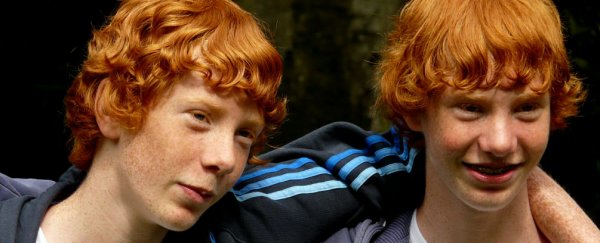Identical twins who play all the same sports as kids, but who adopt different exercise routines as adults, could develop very different bodies and brains, a new study suggests.
Researchers from the University of Jyväskylä in Finland have conducted a small but intriguing study - dubbed FITFATTWIN - which highlights the role physical activity plays in regulating not only our health, but the structure of our brains.
By examining the divergent exercise habits of identical twins, the researchers showed that more active twins not only had better cardiovascular fitness than their sedentary siblings, they also had more grey matter, particularly in regions of the brain associated with motor control and coordination.
While physical activity and fitness are generally associated with a range of health benefits, such as reduced body fat, better cognitive function, and reduced prevalence of chronic diseases such as diabetes and heart diseases, it's actually quite difficult to pinpoint the long-term benefits of exercise.
As the researchers point out, long-term, randomised control studies in exercise science are difficult to organise, costly, and are limited by hard-to-account-for factors such as genetics and upbringing, both of which influence health, endurance and attitudes toward exercise.
So to measure the impact of lifestyle on health, they decided to focus on identical twins - individuals who share the exact same DNA and very similar past experiences.
To find their subjects, the researchers turned to the Finntwin16 study, which had collected behavioural and health information via surveys from a large cohort of Finnish twins over a number of years.
The team managed to locate 10 pairs of identical male twins from Finland in their early 30s that were of interest. Importantly, while the twins reported having similar diets, sometime within the last three years they had each adopted rather different exercise routines. Those that reported being less active said this was largely a result of work or family obligations.
The researchers invited the 10 sets of twins to their lab where they measured their height, weight and body fat, took blood samples to measure their insulin sensitivity and metabolic health, and they also took a brain scan.
Not only were the more active twins fitter, they were seen to be less susceptible to the onset of chronic diseases such as diabetes in later life. Furthermore, they also had more grey matter in their striatum and prefrontal cortex.
Gretchen Reynolds from The New York Times paraphrased her discussion with one of the study's authors: "Presumably, all of these differences in the young men's bodies and brains had developed during their few, brief years of divergent workouts, underscoring how rapidly and robustly exercising - or not - can affect health, said Dr Urho Kujala… More subtly, the findings also point out that genes and environment 'do not have to be' destiny when it comes to exercise habits, Dr Kujala said."
The team's results were published in the journal Medicine and Science in Sports and Exercise.
Source: The New York Times
